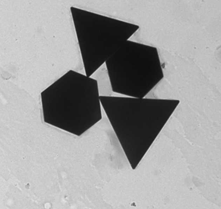Gold Nanoparticle Functionalization Methods
Discrete Methods and Applications
To functionalize gold nanoparticles, various techniques have been developed, offering efficient and versatile methods for modifying the surface of these nanoparticles to tailor their properties for specific applications. One approach involves the use of thiol-ligands in a water/organic solvent mixture, allowing for rapid grafting of thiol groups onto the gold nanoparticle surface Fontana et al. (2014). Additionally, a rapid one-pot method utilizing photochemistry has been presented for functionalizing gold nanoparticles with folic acid (Castillo et al., 2013). Furthermore, a simple and facile method for the functionalization of thiol-coated gold nanoparticles using microwave-assisted 1,3 dipolar cycloadditions has been described (Sommer & Weck, 2007).
Functionalization of gold nanoparticles has also been achieved through the surface modification with surfactants or polymer chains to overcome challenges associated with their use (Etxeberria et al., 2013). Moreover, the development of oligonucleotide-coated metallic nanoparticles as a flexible platform for molecular imaging agents has been presented, demonstrating the potential for functionalization with a variety of biomolecules (Nitin et al., 2007). Additionally, the creation of fullerenethiolate-functionalized gold nanoparticles has been reported, introducing a new class of surface-confined metal−C60 nanocomposites (and & Nakai, 2001).
Biological methods for gold nanoparticle synthesis using plant extracts have attracted attention as eco-friendly alternatives to chemical and physical methods, offering a cleaner and simpler approach to nanoparticle synthesis (Ren et al., 2012). Furthermore, the use of aptamers and reagents based on gold nanoparticles for the detection of Escherichia coli has been demonstrated, showcasing the potential for functionalization in biosensing applications (Pięta et al., 2013).
In summary, the functionalization of gold nanoparticles encompasses a wide range of techniques, including thiol-ligand grafting, photochemical methods, microwave-assisted cycloadditions, surface modification with polymers, and biological synthesis. These methods offer diverse and efficient approaches to tailor the properties of gold nanoparticles for various applications, from molecular imaging to biosensing.
Go here for Nanopartz Gold Nanoparticle Analytical Methods
References:
Akbarzadeh, A., Zare, D., Farhangi, A., Mehrabi, M., Norouzian, D., Tangestani, S., … & Bararpour, N. (2009). Synthesis and characterization of gold nanoparticles by tryptophane. American Journal of Applied Sciences, 6(4), 691-695. https://doi.org/10.3844/ajas.2009.691.695
Bard, A., Rondon, R., Marquez, D., Lanterna, A., & Scaiano, J. (2018). How fast can thiols bind to the gold nanoparticle surface?. Photochemistry and Photobiology, 94(6), 1109-1115. https://doi.org/10.1111/php.13010
Boksebeld, M., Blanchard, N., Jaffal, A., Chevolot, Y., & Monnier, V. (2017). Shape-selective purification of gold nanorods with low aspect ratio using a simple centrifugation method. Gold Bulletin, 50(1), 69-76. https://doi.org/10.1007/s13404-017-0197-9
Castillo, J., Bertel, L., Páez-Mozo, E., & Martínez, F. (2013). Photochemical synthesis of the bioconjugate folic acid-gold nanoparticles. Nanomaterials and Nanotechnology, 3, 18. https://doi.org/10.5772/57144
Chithrani, D., Ghazani, A., & Chan, W. (2006). Determining the size and shape dependence of gold nanoparticle uptake into mammalian cells. Nano Letters, 6(4), 662-668. https://doi.org/10.1021/nl052396o
Etxeberria, H., Zalakain, I., Tercjak, A., Eceiza, A., Kortaberria, G., & Mondragon, I. (2013). Functionalisation of cdse semiconductor nanoparticles with polystyrene brushes by radical polimerization. Journal of Nanoscience and Nanotechnology, 13(1), 643-648. https://doi.org/10.1166/jnn.2013.6858
Fontana, J., Spillmann, C., Naciri, J., & Ratna, B. (2014). A technique to functionalize and self-assemble macroscopic nanoparticle-ligand monolayer films onto template-free substrates. Journal of Visualized Experiments, (87). https://doi.org/10.3791/51282
Gomez, L., Sebastian, V., Arruebo, M., Santamaria, J., & Cronin, S. (2014). Plasmon-enhanced photocatalytic water purification. Physical Chemistry Chemical Physics, 16(29), 15111. https://doi.org/10.1039/c4cp00229f
Jeon, J., Shim, H., Mushtaq, S., Choi, M., Park, S., Choi, D., … & Jang, B. (2016). An optimized protocol for the efficient radiolabeling of gold nanoparticles by using a <sup>125</sup>i-labeled azide prosthetic group. Journal of Visualized Experiments, (116). https://doi.org/10.3791/54759
Liu, L., Guo, Z., Xu, L., Xu, R., & Xiang, L. (2011). Facile purification of colloidal nir-responsive gold nanorods using ions assisted self-assembly. Nanoscale Research Letters, 6(1). https://doi.org/10.1186/1556-276x-6-143
Lohse, S., Eller, J., Sivapalan, S., Plews, M., & Murphy, C. (2013). A simple millifluidic benchtop reactor system for the high-throughput synthesis and functionalization of gold nanoparticles with different sizes and shapes. Acs Nano, 7(5), 4135-4150. https://doi.org/10.1021/nn4005022
López‐Lorente, Á., Simonet, B., & Valcárcel, M. (2012). Rapid analysis of gold nanoparticles in liver and river water samples. The Analyst, 137(15), 3528. https://doi.org/10.1039/c2an35343a
Nitin, N., Javier, D., & Richards‐Kortum, R. (2007). Oligonucleotide-coated metallic nanoparticles as a flexible platform for molecular imaging agents. Bioconjugate Chemistry, 18(6), 2090-2096. https://doi.org/10.1021/bc0701242
Pięta, P., Szczerba, A., Dobroczyńska, J., & Grabas, K. (2013). Application of an aptamer and a reagent based on gold nanoparticles for detection of escherichia coli. Environment Protection Engineering, 39(4). https://doi.org/10.37190/epe130411
Ren, F., He, X., Wang, K., & Yin, J. (2012). Biosynthesis of gold nanoparticles using catclaw buttercup (<i>radix ranunculi ternati</i>) and evaluation of its colloidal stability. Journal of Biomedical Nanotechnology, 8(4), 586-593. https://doi.org/10.1166/jbn.2012.1417
Sommer, W. and Weck, M. (2007). Facile functionalization of gold nanoparticles via microwave-assisted 1,3 dipolar cycloaddition. Langmuir, 23(24), 11991-11995. https://doi.org/10.1021/la7018742 Tsalsabila, A., Herbani, Y., & Sari, Y. (2022). Study of lysine and asparagine as capping agent for gold nanoparticles. Journal of Physics Conference Series, 2243(1), 012102. https://doi.org/10.1088/1742-6596/2243/1/012102
Vernickaite, E., Bubniene, U., Cesiulis, H., Ramanavicius, A., & Podlaha, E. (2016). A hybrid approach to fabricated nanowire-nanoparticle composites of a co-w alloy and au nanoparticles. Journal of the Electrochemical Society, 163(7), D344-D348. https://doi.org/10.1149/2.1401607jes
Zhu, T., Vasilev, K., Kreiter, M., Mittler, S., & Knoll, W. (2003). Surface modification of citrate-reduced colloidal gold nanoparticles with 2-mercaptosuccinic acid. Langmuir, 19(22), 9518-9525. https://doi.org/10.1021/la035157u
and, H. and Nakai, H. (2001). Fullerenethiolate-functionalized gold nanoparticles: a new class of surface-confined metal−c60 nanocomposites. Langmuir, 17(21), 6393-6395. https://doi.org/10.1021/la0111250

